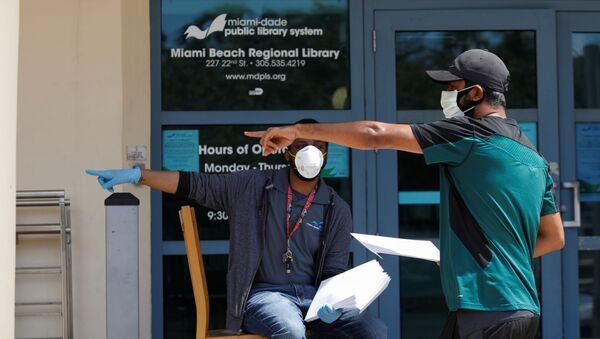Despite US President Donald Trump’s coronavirus relief package, big banks are resistant to processing loans for small businesses, Jack Rasmus, a professor of economics at Saint Mary's College of California and author of “The Scourge of Neoliberalism: US Economic Policy from Reagan to Trump,” told Sputnik Friday.
“The problem is, small businesses aren’t being really rescued. They have this $350 billion fund, and a lot of it is loans, but the loans go into the big banks from the Fed [US Federal Reserve], and then the big banks have to make the loans to small businesses,” Rasmus told hosts John Kiriakou and Brian Becker.
“Well, that’s not getting out there either. So, a lot of talk, a lot of legislation has been passed, but nothing has really been implemented very much. And in the meantime, the economy continues to crash. A lot of these small businesses will never come back. Small businesses have only, on average, 27 days of cash to cover their cash flow needs, and it’s been about 27 days. They’re running out of money, and they’re going under, and a lot of them will never come back. That is going to have repercussions for their [small businesses’] recovery,” Rasmus explained.
Starting April 3, the self-employed, small businesses and charities were able to apply for loans under the Paycheck Protection Program.
"We need to get money to small businesses and American workers, and that’s what we are doing,” US Treasury Secretary Steve Mnuchin said at a White House briefing earlier this month. "This will be up and running tomorrow. I encourage all small businesses that have 500 or fewer people, please, contact your lenders ... You get the money, you’ll get it the same day, you use it to pay your workers.”
A study released by the National Federation of Independent Business (NFIB) on Thursday found that 70% of US small businesses have attempted to apply for an emergency loan. However, not all business owners have had success in receiving financial aid.
“The Fed is issuing what it calls the ‘Main Street Program,’ which really has little to do with main street. It has to do with providing another $600 billion to mid-sized corporations,” Rasmus told Sputnik, noting that mid-sized referred to firms with between 500 and 10,000 employees.
“So, there’s a lot of money flowing to businesses through the Fed, by the way, and through the Congress. And we've got $500 billion going to another 165 million workers out there, which is going to last about six to eight weeks, but it hasn’t even gotten through yet. And the longer it actually takes to get this money into people’s hands, the more the economy contracts and crashes and the faster it does. And that means, the deeper it goes, the more unlikely it's going to be a quick recovery,” Rasmus explained.
In an April 1 piece on his website, titled “Covid 19 & the FORGOTTEN Working Class,” Rasmus argues that the US government is giving trillions of dollars in grants and loans to large corporations and businesses, rather than to those in the working class who need relief.
“Why are we short-changing those workers who are the real source of keeping the entire system from collapsing during this crisis, who are keeping the economy - or what’s left of it - still running?” he asks in the article.
In addition, Rasmus explained that the number of people who are currently unemployed is far more than the roughly 18 million Americans who have filed for unemployment benefits in the past month.
“The unemployment numbers, as you indicated here, those filing unemployment benefits - millions a week, almost 18 million here in just three weeks. But that’s not the total unemployed, you see - that’s those who apply for benefits. Don’t confuse receiving benefits with the number of unemployed, because a lot of people aren’t eligible for unemployment. They can’t file, or they file late, or as what’s happening now, they have a very difficult time getting through the bureaucracy. There’s not enough people to assist them in filing for unemployment,” Rasmus noted.



